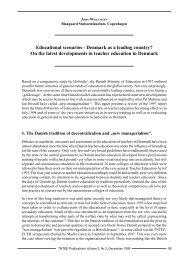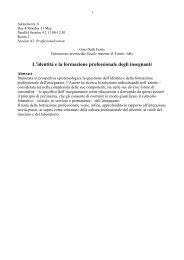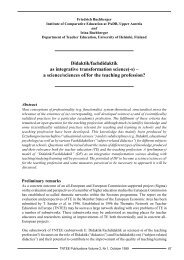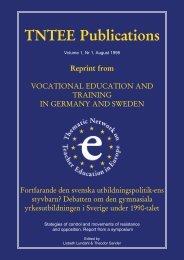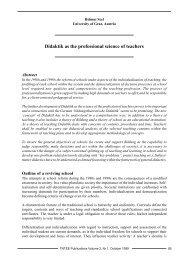TNTEE Publications - Didaktik/Fachdidaktik
TNTEE Publications - Didaktik/Fachdidaktik
TNTEE Publications - Didaktik/Fachdidaktik
You also want an ePaper? Increase the reach of your titles
YUMPU automatically turns print PDFs into web optimized ePapers that Google loves.
arena” of teacher education where different interest groups and lobbies try to keep their influence in<br />
a social “power game” (e.g. scientific/academic disciplines). The result of this power game may be<br />
that adaptations and re-orientations that are necessary because of changes in the context are not<br />
made. On the topic of statement (5) a preliminary model of DF as an integrative transformative<br />
science dealing with teaching-studying-learning is presented. Drawing on the work of Klafki, the<br />
notion of Allgemeinbildung (basic competence) is seen as of central importance. This model is<br />
seen as offering the possibility of opening up widely neglected areas of research into teaching and<br />
learning and also of contributing to the constructive empowerment of the teaching profession. In<br />
addition it is seen as offering the potential to reduce the dependency on external and political<br />
control including that from non-teaching related academic disciplines.<br />
In his outline of <strong>Didaktik</strong> as the professional science of teachers in chapter 6, Helmut Seel highlights<br />
the tension between the pedagogical and didactical tradition of “geisteswissenschaftliche Pädagogik”<br />
(and the associated notion of “relative pedagogical autonomy for school and teachers”) in German<br />
speaking countries with the more narrowly focussed Anglo-American concept of teaching theory.<br />
He also draws attention to Shulman’s critique of a lesson-related instructional theory as being too<br />
limited for a scientific basis for professional practice. Further he highlights Shulman’s critique of<br />
an exclusively psychological orientation on associated research. He also notes how a “renaissance<br />
of <strong>Didaktik</strong>” has taken place in German-speaking countries in recent years and proposes the need<br />
for such scientific theory and reflective practice in general. In outlining the professional science of<br />
teaching he identifies three components as firstly a theory of teaching, secondly a theory of Bildung<br />
and thirdly a theory of school. In his final section he considers the relation between <strong>Didaktik</strong> and<br />
subject-related studies which is seen as problematic and in need of clarification. A key issue is the<br />
unstable nature of subjects within the school system. For example some subjects were initially seen<br />
as knowledge and attitudes to deal with certain phenomena and problem areas of life, e.g. Erdkunde,<br />
Naturkunde, Wirtschaftkunde etc, whereas others were seen as skills such as languages, arithmetic<br />
and crafts. Also some subject disciplines are not represented at all in the elementary and lower<br />
secondary school systems such as medicine, law, astronomy and economics. A further key issues<br />
centres on the problems created by the organisation of the school into isolated subject-matter<br />
compartments. Such organisation is seen to run counter to the need for the integration of subject<br />
matters when faced with real life problems of a societal or personal nature. One way of overcoming<br />
these problems is seen to be through cross-curricular project-based approaches. Finally Seel points<br />
to the need for a continuous evaluation of the dynamic relationship between general didactics and<br />
subject-matter didactics.<br />
In chapter 7, Gunn Imsen emphasises the distinction between the normative and descriptive aspects<br />
of <strong>Didaktik</strong> and addresses the notion of reflection as a “bridging concept” in this context. The<br />
normative aspect is seen as seeking principles and procedures to decide about aims, subject matter<br />
and teaching-learning methods in education, mostly for the purpose of educational planning. The<br />
descriptive aspect of didactics is seen to focus upon the teaching-learning reality, its contexts and<br />
the students’ learning experiences, in order to understand the educational process. Traditionally<br />
and philosophically, these two aspects are seen to be clearly separate, though in educational practice,<br />
these two parts of didactics are seen to be intertwined. This chapter presents a comprehensive,<br />
analytical model, mapping the main components that make up the life in classrooms. This model is<br />
offered to serve as a tool in order to understand and to some extent explain the relationships between<br />
factors influencing classroom life. The ways to change in teachers’ practices are seen to be in how<br />
they connect and combine normative ideas and descriptive information. Thus, reflection is seen as<br />
a core concept in the attempt to bridge the divide between these two aspects. The model is based on<br />
a perspective that sees ideas never working directly on teaching, but “through those teachers that<br />
will transmit them into practical activity”. It is emphasised that in order to understand this “a<br />
<strong>TNTEE</strong> <strong>Publications</strong> Volume 2, Nr 1, October 1999 5



